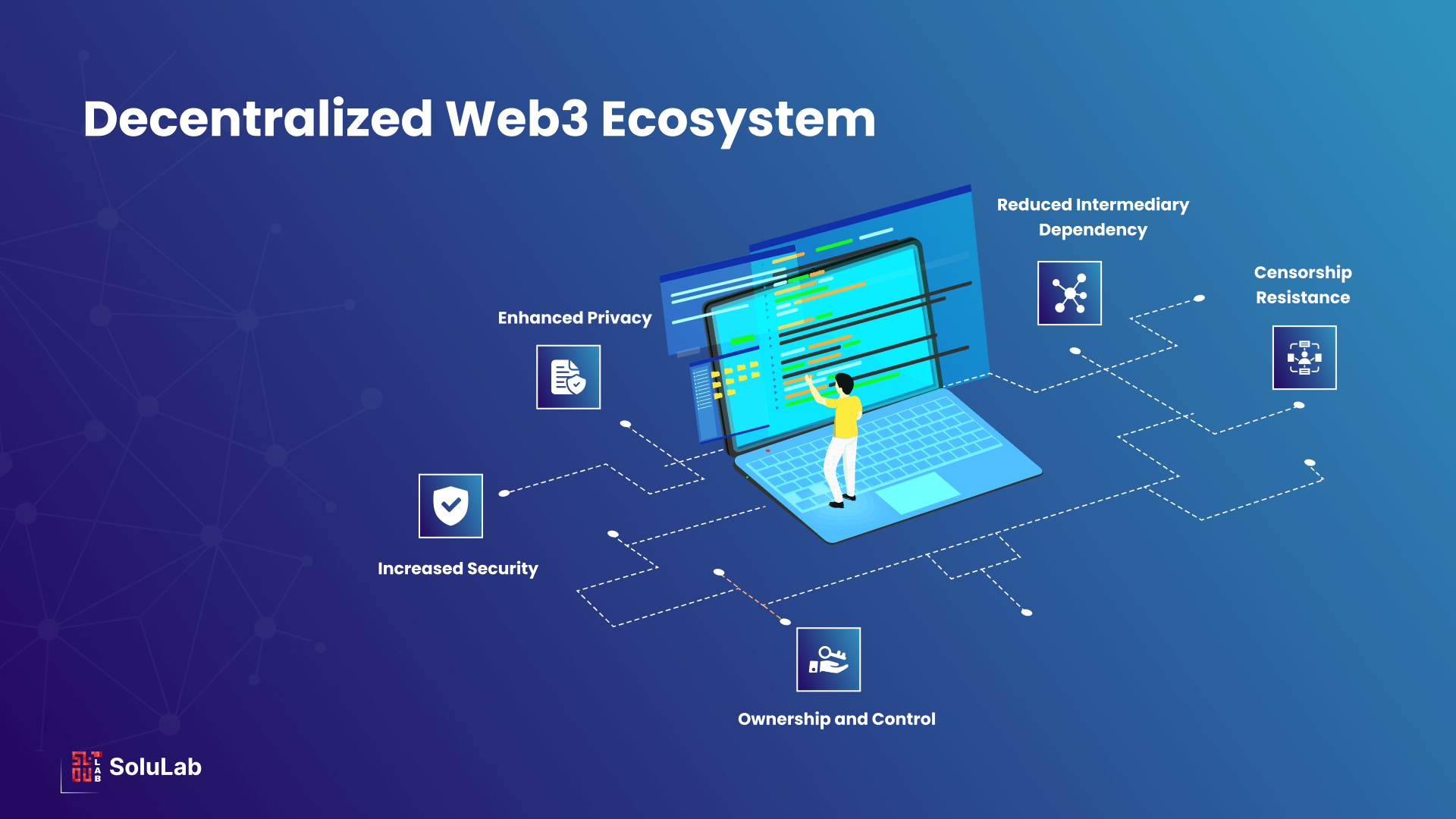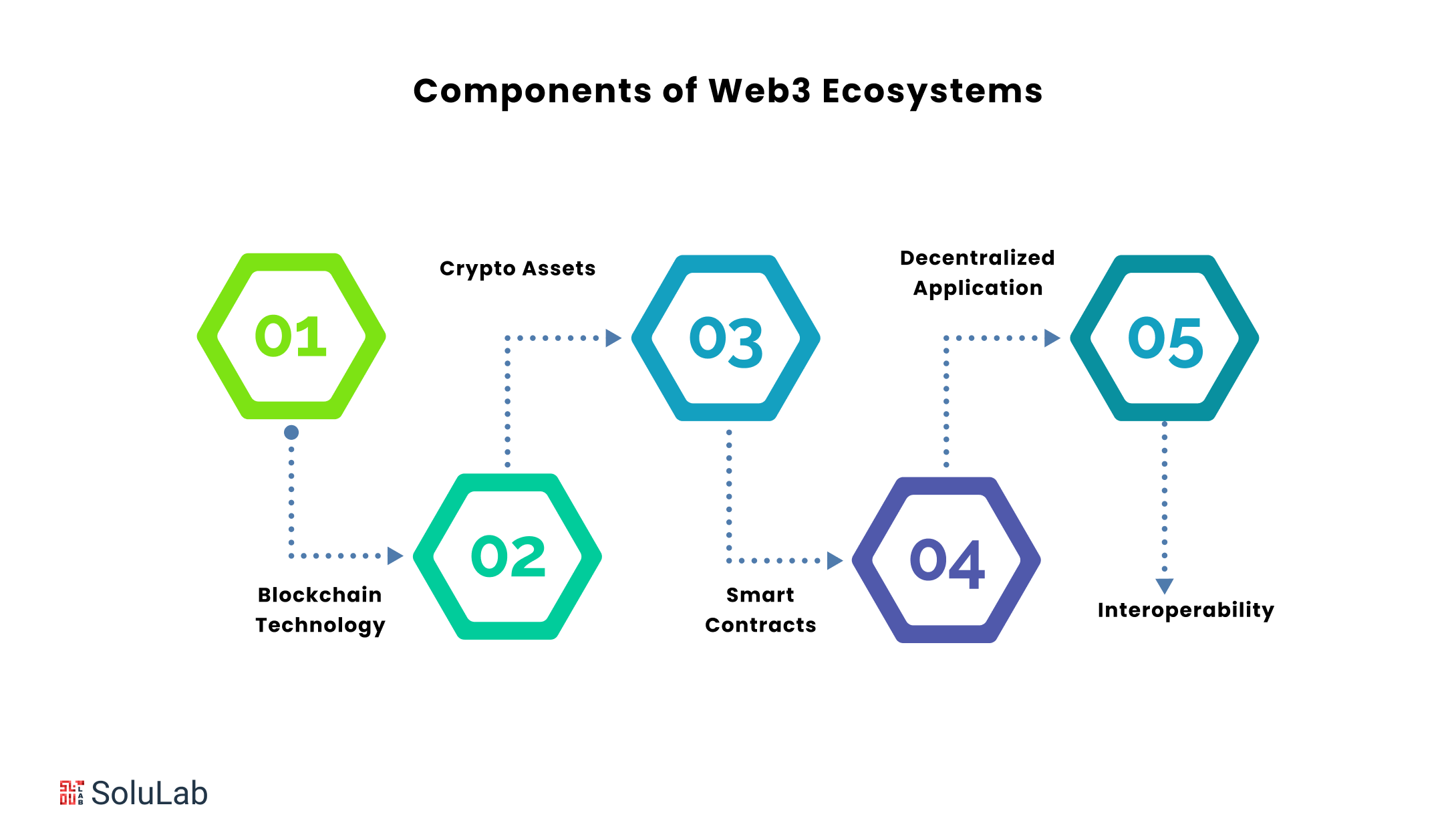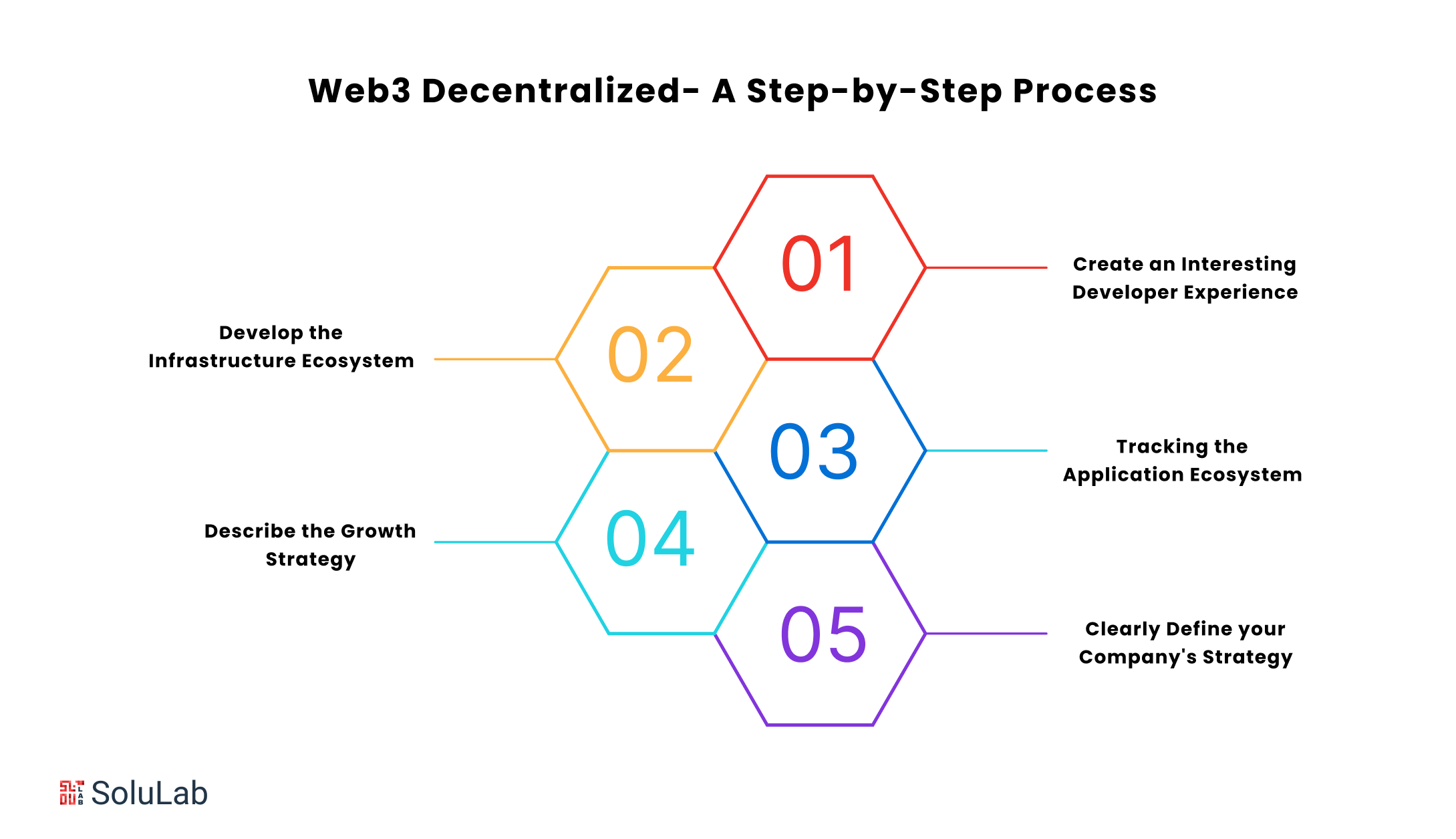
Web 3.0 could be the next version of the internet. It relies on public blockchains, a type of record-keeping system often used for cryptocurrency transactions. The key thing about Web 3.0 is that it’s not controlled by big companies like Google or Facebook. Instead, individuals own and manage parts of the internet themselves.
In Web 3.0, you don’t need permission to access services, meaning big authorities don’t control who can use what. Also, there’s no need for trust in intermediaries for online transactions. This makes Web 3.0 better at protecting user privacy since it reduces the role of agencies and intermediaries in collecting data. In this guide, we will explore how to create a decentralized Web3 ecosystem, how it works, and what the benefits are.
So, without any further ado, let’s get started!
What is Web3 Technology?
Web3 represents the next phase of the internet’s evolution, characterized by a decentralized and user-centric approach. Unlike its predecessors, Web3 leverages blockchain technology to facilitate peer-to-peer interactions without the need for intermediaries. It encompasses a range of technologies, protocols, and principles that empower users, ensuring greater transparency, security, and control over their digital interactions.
Key characteristics of Web3 include the use of decentralized ledger technology, smart contracts, and distributed storage systems, collectively redefining the way information and value are exchanged online. In essence, Web3 aims to create a more open, inclusive, and user-driven internet ecosystem.
Significance of Decentralization in Web3
Decentralization lies at the core of Web3, offering several key advantages that address the limitations of traditional, centralized web architectures.
- Increased Security: In a decentralized Web3 ecosystem, data is distributed across a network of nodes, making it less susceptible to single points of failure and malicious attacks. This distributed nature enhances the overall security of the system.
- Enhanced Privacy: Decentralization empowers users with greater control over their personal data. With no central authority controlling access, individuals can transact and interact online with increased privacy and autonomy.
- Reduced Intermediary Dependency: Web3 eliminates the need for intermediaries in various online processes. Smart contracts, for example, automate and execute agreements without the involvement of third parties, reducing costs and potential points of friction.
- Censorship Resistance: Decentralization makes it challenging for any single entity to control or censor information flow. This resistance to censorship is particularly crucial in promoting freedom of expression and ensuring that information remains accessible to all.
- Ownership and Control: Web3 enables users to have true ownership of their digital assets, such as tokens and data. Through decentralized identity and blockchain-based systems, individuals have more control over their online presence and transactions.
Understanding the significance of decentralization in Web3 is essential for dedicated developers and users alike, as it forms the foundation for a more resilient, secure, and user-centric internet. Embracing these principles can lead to a paradigm shift in how we interact with the digital world.
Important Components of Web3 Ecosystems

As discussions surrounding Web3 often revolve around decentralization and its pivotal role, understanding what makes Web3 decentralized becomes crucial. The emphasis on decentralization mitigates bureaucratic risks, fostering innovation, accountability, autonomy, and responsiveness to user needs and market dynamics.
Web3 and Decentralization serve as a foundational pillar, ushering in a paradigm shift that opens doors for innovation while minimizing bureaucratic hurdles. Its contribution to improved accountability, autonomy, and responsiveness to user demands and market conditions makes it a vital feature of Web3 ecosystems.
1. Blockchain Technology
Blockchain technology serves as the bedrock of Web3, providing a decentralized network for storing and exchanging data. Its distributed ledger structure ensures a secure environment for developing, distributing, and trading digital assets without the intervention of centralized entities.
2. Crypto Assets
Crypto assets, such as tokens and cryptocurrencies, leverage blockchain decentralization for executing secure digital transactions. These digital assets not only serve as native currencies for decentralized applications (dApps) but also play a crucial role in participating in Web3 governance.
3. Smart Contracts
Smart contracts, as self-executing computer programs, enable the programmability of transactions based on pre-determined conditions. These contracts empower the creation of innovative dApps, forming a cornerstone for the dynamic landscape of Web3.
4. Decentralized Applications (dApps)
Web3 introduces decentralized applications that combine interactive experiences with decentralization. dApps facilitate activities like buying or selling non-fungible tokens (NFTs), crypto trading, and access to decentralized finance (DeFi) solutions, offering users greater control over their online interactions.
5. Interoperability
Interoperability is a crucial component of a decentralized Web3 ecosystem, allowing users to communicate and utilize their digital assets across different platforms seamlessly. In Web3, users have complete control over their data, a stark contrast to the centralized control exerted by companies in the Web2 landscape.
In brief, understanding and embracing these key components are essential for building a robust Web3 ecosystem, fostering creativity, and reshaping the digital landscape towards a more decentralized and user-centric future.
Web3 Application Development Across Diverse Sectors
Web3 decentralized application development is catalyzing transformative changes across various sectors, introducing decentralized applications (dApp) solutions that redefine conventional practices. Below is a succinct overview of the impact of Web3 decentralized applications in diverse niches:
1. Finance: Web3 applications in the financial sector facilitate transparent and trustless transactions, streamline cross-border payments, and introduce decentralized finance (DeFi) solutions, promoting financial inclusivity through decentralized and transparent mechanisms.
2. Healthcare: In healthcare, Web3 applications ensure secure and interoperable data sharing, empower patients with control over their health records, and optimize processes like drug traceability through blockchain, enhancing data security and patient-centric care.
3. Supply Chain: Transforming supply chain management, Web3 applications enhance transparency and traceability, empowering organizations and consumers to verify the authenticity of products throughout the supply chain using decentralized ledgers.
4. Real Estate: Revolutionizing real estate transactions, Web3 applications introduce smart contracts for seamless property transactions, and fractional ownership, and maintain transparent property history on the blockchain, reducing reliance on intermediaries.
5. Gaming: In the gaming industry, Web3 applications introduce tokenization of in-game assets, ensuring true ownership, transparent reward systems, and cross-game asset interoperability, creating a decentralized gaming ecosystem.
6. Identity Management: Web3 applications redefine identity management, allowing users to securely control their digital identities across platforms, mitigating the risk of identity theft through decentralized and user-centric solutions.
Related: Top 10 Web3 Use Cases
7. Education: Transforming education, Web3 applications enable secure and transparent credential verification, tokenized certifications, and decentralized learning platforms, enhancing the integrity and accessibility of educational records.
8. Energy: In the energy sector, Web3 applications introduce transparent energy trading platforms, facilitate peer-to-peer energy transactions, and optimize the efficiency of energy grids through decentralized solutions, fostering a more sustainable and efficient energy ecosystem.
9. Social Media: Web3 applications in social media prioritize user ownership of data, eliminate centralized control, and often integrate tokenized incentives for content creators and users, reshaping the dynamics of online social interactions.
10. Governance: Web3 applications bring decentralized governance models, allowing communities to actively participate in decision-making processes through consensus mechanisms, fostering more inclusive and transparent governance structures.
In each sector, the advent of decentralization Web3 applications signifies a shift towards decentralization, transparency, and user empowerment, revolutionizing traditional industries and paving the way for a more inclusive and efficient future.
How is Web3 Decentralized- A Step-by-Step Process

A thorough comprehension of the solutions to the question “What is the ecosystem of web3?” would have helped you grasp the critical needs for web3 ecosystems. Here are some of the important processes you may encounter while developing a web3 ecosystem.
1. Create an Interesting Developer Experience
The most important prerequisite for growing your web3 ecosystem is to create a compelling development experience. Furthermore, the availability of assistance might aid in acquiring the trust of early adopters who may use the platform. Satisfied users may assist in driving recommendations for the web3 platform via word of mouth.
The road to constructing a decentralized web3 environment necessitates a thorough grasp of the roles involved in developing the developer experience. The steps involved in developing a developer experience for the web3 ecosystem include responding to developer inquiries. Other phases in building developer experience involve the development of code templates and developer tools.
The staff focused on developer experience might provide a variety of services, like keeping track of developer FAQs. They could also set up a developer portal to assist people in accessing documentation and template code. The developer experience team might also provide code evaluations to partners who are developing large-scale blockchain projects inside the web3 ecosystem.
The setup of a high-availability developer support channel on platforms like Telegram and Discord, along with the use of community moderators, may additionally enhance the developer experience. The developer site might be the primary point of contact for developers seeking the security of the community’s organic growth. It’s also crucial to note that you should enhance the developer experience roadmap and address any particular concerns.
2. Develop the Infrastructure Ecosystem
Ethereum is the preferred choice for building a web3 app. It is common among developers because of its open-source tools. Hardhat and Truffle are two development frameworks that may be used to quickly create, compile, test, and deploy blockchain technology applications. In addition, OpenZeppelin provides users with a set of certified open-source Ethereum primitives.
The answers to the question ‘What is decentralized in web3?’ would indicate the technical layer, specifically blockchain. You can look at various blockchains to develop your web3 ecosystem. For example, Solana is a popular choice with blockchain networks that use open-source frameworks to build ecosystems.
Solana’s DeFi ecosystem has grown exponentially with the development of an open-source architecture for the platform. Anchor powered several of the Solana ecosystem’s top DeFi projects in terms of TVL, including Metaplex and Mango. Anchor resulted in a significant increase in production, expanding the Solana DeFi ecosystem by large margins in early 2022.
The blockchain infrastructure largely focuses on the backend operations necessary for dApps. Backend features comprise node providers, smart contract programming languages, blockchain explorers, web3 APIs, wallets, and development frameworks. You must comprehend the many levels of infrastructure in a web3 ecosystem. Layer 1 comprises blockchain networks, layer 2 contains node providers, layer 3 includes APIs and the 4th layer comprises web development tools.
3. Tracking the Application Ecosystem
The application ecosystem has to be mapped after the web3 ecosystem’s base or infrastructure has been established. Comprehending the workings of web3 would facilitate your grasp of the significance of evaluating the teams that are already operating within the ecosystem. It’s critical to search for any areas that require improvement.
A web3 ecosystem team that works well should be well-versed in the components that are lacking. They also need to be constantly brainstorming new concepts to advance the web3 ecosystem. To assist developers in turning their ideas into reality, the ecosystem team must also actively support them.
By including several web3 application types in your decentralized ecosystem, you may create a decentralized web3 ecosystem. Decentralized finance, NFTs, the metaverse, play-to-earn games, identification and authentication, governance, predictive markets, enterprise use cases, and social media are among the applications.
After accurately identifying the gaps, you need to create a list of concepts that you can present to other people. The ecosystem must simultaneously solicit submissions with fresh concepts. The Ethereum Foundation’s “Request for Proposal” and Y Combinator’s “Request for Startups” are two instances of these strategies.
While creating the decentralized web3 ecosystem, you also need to map out the teams who have the necessary expertise to construct specific prototypes. You should also make requests for explicit product specifications that include deadlines. If the team is unable to get funding, grants for developer tools or solutions without business models may be available. Stakeholders voting on governance ideas might be possible in a governance forum with an efficient user interface for decentralized protocols. It should also be possible to assess proposals for grant acceptance or delegation through the user interface.
4. Describe the Growth Strategy
The next stage of creating your web3 ecosystem is all about expansion. By now, you are aware of the components of your web3 ecosystem and the prerequisites for creating it. As a result, you should look for solutions to help your web3 ecosystem flourish rather than sticking to basic queries like “What is the ecosystem of web3?”
The components of community building, marketing, and commercial development would determine how quickly the web3 ecosystem expanded. Planning your expansion strategy might involve hiring early hires to get developer feedback and sourcing from broad networks.
The web3 ecosystem’s greatest growth recruits are methodical thinkers who pay close attention to details. Above all, it’s possible that the growth hires will feel compassion for their clients. Team members must comprehend the web3 platform’s value proposition in addition to having tactical skills and the capacity to improve outreach.
Since protocol teams could not follow the in-house strategy to create everything, the rise of third-party developers is closely correlated with the emergence of a web3 ecosystem. For example, in order to establish crypto-native infrastructure—which was necessary for creating large-scale applications—Terraform Labs concentrated on smaller development teams. Additionally, the web3 platform engaged developers by organizing hackathons and other hacker events.
You may welcome larger enterprises in social media, gaming, and e-commerce once the web3 ecosystem reaches critical mass. Bigger businesses would be keen to develop a web3 application on platforms with dependable infrastructure and readymade fixes. However, it’s crucial to remember that integrating a large corporation into your web3 environment might be difficult. Nonetheless, you may make use of their current user base’s advantages to increase web3 ecosystem volume and provide value to your brand.
5. Clearly Define your Company’s Strategy
Once an ecosystem has been built, you may focus on creating a long-term plan to protect your web3 ecology in the future. You should concentrate on the platform’s value proposition and the engineers’ next top priority. Companies involved in web3 and blockchain technology have begun to record higher earnings in addition to growing their market share. Various organizations are strengthening their company strategy by strengthening their internal teams and focusing on fresh concepts.
Once the foundation of your Web3 ecosystem is in place, the next critical step involves developing a clear and comprehensive corporate strategy to ensure its long-term success. Central to this strategy is a deep understanding of the platform’s unique value proposition and a keen focus on addressing the evolving priorities of developers within the ecosystem. Notably, as blockchain and Web3 development companies witness increasing profits and expanded market presence, it becomes imperative for your organization to stay ahead by fostering innovation. This often involves exploring new ideas, leveraging internal teams for dedicated support, and continuously adapting to the dynamic landscape of decentralized technologies. Strengthening the corporate strategy in this manner not only secures the future of the Web3 ecosystem but also positions your organization as a leader in the rapidly evolving blockchain space.
Benefits of Developing a Web3 App

Building a Web3 app comes with a myriad of benefits, rooted in the principles of decentralization and secure identity management. Here are key advantages that highlight the significance of developing a Web3 application:
-
Decentralization Empowers Trust
Embracing Web3’s decentralized architecture enhances trust in digital interactions. Without relying on a central authority, transactions, data exchanges, and smart contracts are executed on a transparent and tamper-resistant blockchain, fostering a more trustless environment.
-
Enhanced Security and Data Privacy
Web3 apps prioritize user data security and privacy. With Web3 decentralized identity management, users have greater control over their personal information, mitigating the risks associated with centralized data repositories. This heightened security reduces the likelihood of identity theft and unauthorized access.
-
User-Centric Identity Management
Web3 introduces a paradigm shift in identity management, placing users at the center of their digital identities. Through decentralized identity solutions, individuals can securely control and manage their online personas across various platforms, reducing reliance on centralized entities.
-
Interoperability Across Platforms
Web3 apps promote interoperability, enabling users to seamlessly interact and use their digital assets across different platforms. This contrasts with Web2, where data is often under the centralized control of companies. In a Web3 ecosystem, users have greater autonomy and control over their digital presence.
-
Facilitating Web3 Ecosystem Integration
Developing a Web3 app allows integration into the broader decentralized ecosystem. This interconnectedness opens avenues for participation in decentralized finance (DeFi) solutions, tokenized ecosystems, and other innovative decentralized applications, fostering a collaborative and thriving digital environment.
-
Transparency and Tamper-Resistance
The use of blockchain technology in Web3 ensures transparency and tamper-resistance of data. Transactions and actions recorded on the blockchain are immutable, providing a verifiable and transparent history. This transparency instills confidence among users and stakeholders in the integrity of the system.
-
Incentivizing User Engagement
Many Web3 apps incorporate tokenized incentives, providing users and content creators with tangible rewards. This approach incentivizes active participation within the ecosystem, creating a dynamic and engaged user community.
-
Future-Proofing Against Centralized Risks
Web3 app development future-proofs against risks associated with centralized systems. With the growing awareness of data breaches and privacy concerns, adopting a decentralized approach ensures resilience against potential centralized vulnerabilities.
In summary, the benefits of developing a Web3 app extend beyond technological innovation, touching on aspects of trust, security, privacy, and user empowerment. Embracing these advantages not only aligns with the ethos of decentralization but also positions your application at the forefront of a rapidly evolving digital landscape.
Conclusion
In conclusion, the journey to build a decentralized Web3 ecosystem is marked by a profound transformation in the way we interact with the digital realm. From the fundamental principles of decentralization to the intricate components like smart contracts, decentralized applications, and interoperability, the path to a Web3 future demands a comprehensive understanding and strategic approach. The emergence of blockchain technology, coupled with the ethos of decentralization, opens up new possibilities for transparent, secure, and user-centric digital experiences. As developers, businesses, and innovators continue to explore and contribute to the Web3 landscape, the potential for reshaping industries, promoting inclusivity, and fostering innovation becomes increasingly tangible. The Web3 journey is not merely a technical evolution but a paradigm shift towards a decentralized, interconnected, and trust-driven digital era.
In this transformative journey, SoluLab stands out as a renowned Web3 development company, offering the best Web3 development services. With a commitment to excellence and a team of skilled professionals, SoluLab empowers businesses to navigate the complexities of the Web3 ecosystem. Their expertise spans blockchain protocols, smart contracts, decentralized applications, and more, ensuring that clients harness the full potential of Web3 technologies. As we embark on this exciting era of decentralized innovation, SoluLab serves as a reliable partner, guiding businesses toward a Web3 future. Elevate your digital presence, embrace decentralization, and unlock the full potential of the Web3 revolution with SoluLab’s advanced Web3 development services. Contact us today to shape the future of your digital endeavors.
FAQs
1. What is the significance of decentralization in Web3 ecosystems?
Decentralization in Web3 ecosystems is crucial as it eliminates reliance on central authorities, fostering transparency, security, and user autonomy. It transforms digital interactions by ensuring trustless transactions, secure data management, and a more inclusive, user-centric internet.
2. How does blockchain technology contribute to the development of Web3 ecosystems?
Blockchain technology serves as the backbone of Web3, providing a decentralized network for storing and exchanging data. It introduces tamper-resistant ledgers, smart contracts, and distributed consensus mechanisms, ensuring the integrity and transparency of digital interactions.
3. What role does SoluLab play in Web3 development, and what services do they offer?
SoluLab is a renowned Web3 development company that excels in providing top-notch Web3 development services. Hire Web3 developers now for a great expertise that spans blockchain protocols, smart contracts, decentralized applications, and more. Our company guides businesses through the complexities of the Web3 ecosystem, empowering them to leverage the full potential of decentralized technologies.
4. How do Web3 apps enhance user privacy and data security?
Web3 apps prioritize user privacy and data security through decentralized identity management. Users have greater control over their personal information, reducing the risk of identity theft and unauthorized access. The decentralized nature of Web3 ensures a more secure and transparent digital experience.
5. What are the key benefits of developing a Web3 app?
Developing a Web3 app comes with numerous benefits, including enhanced trust through decentralization, improved security and data privacy, user-centric identity management, interoperability across platforms, integration into the broader Web3 ecosystem, transparency, tokenized incentives, and future-proofing against centralized risks. Embracing these advantages aligns with the ethos of decentralization and positions Web3 apps at the forefront of a rapidly evolving digital landscape.






